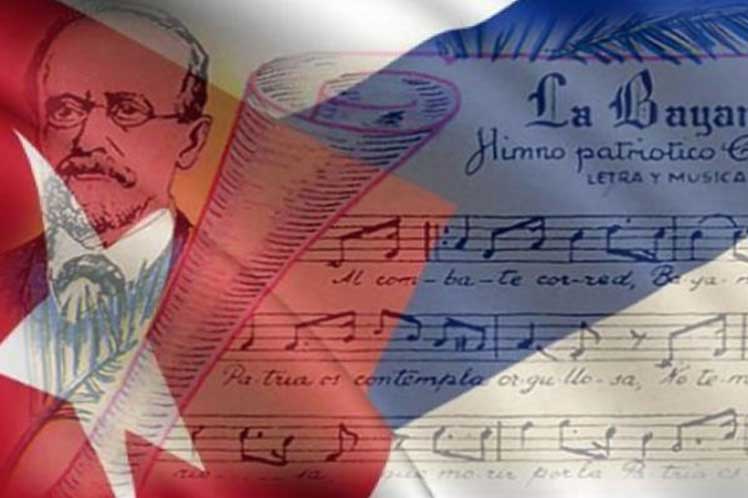
By Ricardo Muñoz Gutiérrez/Contributor
The origin of our National Anthem dates back to 1867, when the Bayamese lawyer Pedro Figueredo Cisneros, Perucho, composed the music and his countryman Manuel Muñoz Cedeño performed the instrumentation. The patriots called it La Bayamesa, to evoke La Marseillaise, a song composed by the French revolutionaries in 1792.
On October 20, 1868, during the taking of the city of Bayamo by the Mambí (Cuban Independence fighter) liberating forces, Perucho himself wrote the lyrics and it was sung for the first time, publicly and with an air of combat. The lyrics of its first two paragraphs, the current National Anthem, were published on October 27 in the newspaper El Cubano Libre.
Later and during the extensive struggle, La Bayamesa was sung in the territories of the Republic of Cuba in Arms. However, in the midst of the vicissitudes of war, the patriotic score was not officially preserved, like thousands of Mambí documents.
So, how did the music of La Bayamesa, the Bayamo or National Anthem, come to our days? Some children of Camagüey were protagonists in this.
On November 10, 1869, when the Mambí Government chaired by Carlos Manuel de Céspedes was camped on the Santa María farm, southwest of the city of Puerto Príncipe, the owner's daughter and almost a child, Adela Morell Oñós, requested Perucho Figueredo, who accompanied the entourage, wrote the melody and lyrics of La Bayamesa.
Adela jealously guarded the treasure and the memory of the author, who graced the moments of leisure sitting at the piano in the house on that estate.
When the visionary José Martí was preparing Necessary War, the rescue of that combat hymn sung in the bush was part of his proselytizing work. For this reason it was published in the Patria newspaper “so that all lips can sing it and all homes can keep it; so that the tears of those who heard him in the sublime combat for the first time may flow with sorrow and love; so that it spurs the blood in the youthful veins.”
The lyrics of the Anthem were obtained from Fernando Figueredo Socarrás, a man from Camagüey who rose up in 1868 and laid down his arms only after the Baraguá Protest.
As independence could not be achieved in 1878, Figueredo Socarrás went abroad and as Martí said he would not return to the country “unless when freedom shines again; a father who has eight children, and he has taught all eight of them the hymn; a Cuban who grows when he remembers the sacred years.”
The musical arrangement, a more difficult matter, was entrusted by Martí to another Camagüeyan, to maestro Emilio Agramonte Piña, a lawyer and musician who went to fight during the Great War and went to live in a foreign country before his own under another flag and Martí said, “he is never as moved as when he remembers those days of sacrifice and glory when the women of his house gave the jewels to the war treasury, when the young men of the house went out, four times in a row, to die.” and, “he only has peace with loyal Cubans.”
Emilio was chosen by the Apostle because “Holy things should not be put in unworthy hands!”
Once colonial rule was expelled, Cuba was occupied by the United States Army and a Military Government that tried by all means to annex the archipelago. But national sentiment on the island was so strong that it made the imperialist plan fail.
In 1900, when Cubans were preparing to establish an independent Republic, they did not forget La Bayamesa because they wanted to officially name it as the National Anthem. In the public and official debate in the Constituent Assembly, a controversy arose.
Adela Morell from Camagüey was a key player in the solution as she kept the album signed by the author of the lyrics. In 1912, the now grandmother Adela donated, through Figueredo who was Perucho's nephew, the valuable documentary treasure to the National Museum, which was preserved much later in the National Museum of Music. (Photo: PL/Archive)
Sources:
-Gómez Cairo, Jesús: Brief history of the National Anthem of Cuba. Editions of the Music Museum. Havana, 2028.
-Sed Nieves, Gustavo: “Of the Cuban National Anthem: a little-known aspect.” In Las Clavellinas. Rev. Special Edition 1/89. Edited by the Department of Revolutionary Orientation and the Historical Research Section of the Provincial Committee of the PCC in Camagüey. Workshops of the Felipe Torres Trujillo Graphic Unit. Camagüey. 1989. Pages 38-39.